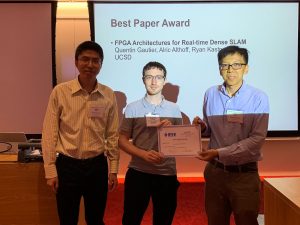Simultaneous localization and mapping (SLAM) is a common technique for robotic navigation, 3D modeling, and virtual/augmented reality. It employs a compute-intensive process that fuses images from a camera into a virtual 3D space. It does this by looking for common features (edges, corners, and other distinguishing image landmarks) over time and uses those to infer the position of the camera (i.e., localization). At the same time, it creates a virtual 3D map of the environment (i.e., mapping). Since this is a computationally expensive task, real-time applications typically can only create a crude or sparse 3D maps.
To address this problem, we built a custom computing system that can create dense 3D maps in real-time. Our system using an FPGA as a base processor. With careful design, it is possible to use an FPGA that it very efficient. “Careful design” typically equates to a painstaking, time consuming manual process to specify the low level architectural details needed to obtain efficient computation.
Our paper “FPGA Architectures for Real-time Dense SLAM” (Quentin Gautier, Alric Althoff, and Ryan Kastner) describes the results of our system design. This was recently published, presented, and awarded the best paper at the IEEE International Conference on Application-specific Systems, Architectures and Processors (ASAP). The paper details the different parts of the InfinitiTAM algorithm, describes the best techniques for accelerating the algorithms, and presents two open-source complete end-to-end system implementations for the SLAM algorithms. The first targets a lower power and portable programmable SoC (Terasic DE1) and the other a more powerful desktop solution (Terasic DE5).
We have found that many SLAM algorithms barely run out of the box. And it is even more challenging to get a hardware accelerated version working. We hope that our open-source repository will be valuable to the broader community and enable them to develop even more powerful solutions.
Links:
Dense SLAM for FPGAs Repository and Technical Paper.
